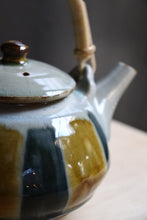
Diameter 13cm x height (to handle) 19cm
Ceramics by Tomohiko Ono is the 5th generation!
Sodeshi Pottery (Sodeshi, Matsue, Japan) Tomoichi Ono founded this style of pottery having studied the craft in Izumo, at an atelier specialised in processing of tea cups at Fujina and Rakuzan.
He opened his own kiln in 1877 at Agenogi Ojizaka on the outskirts of Matsue because of a rich source of good quality clay.
In 1893, Tomoichi was succeeded by 1893 by Iwajiro, who relocated to Sodeshi-gaura and increased the number of kilns to five. The bay provided good transportation access, with a beautiful view of the sunset over Lake Shinji was praised by Lafcadio Hearn (1850-1904), an Irish writer who lived in Matsue for just over a year.
Sodeshi pottery takes its name from the place name where it is located, at the foot of Mt. Kyoko and close to Enjo-ji Temple, where the first feudal lord of Matsue Horio Yoshiharu is enshrined. The methods used at Sodeshi pottery kilns are based upon traditional techniques of Izumo, passed down from generation to generation.
And also incorporate other regional methods to produce hand-made pottery designed for modern living, and features durability, ease of use, and a mix of simplicity and luxury. The glazing material is locally procured, using persimmon-based materials.
The colouring is achieved with iron oxide, cinnabar, cobalt etc. The design work is carried out using a number of methods, including two-colouring, natural drop painting, brushing, inlaying and nail driving










